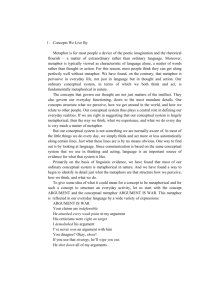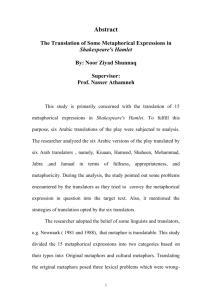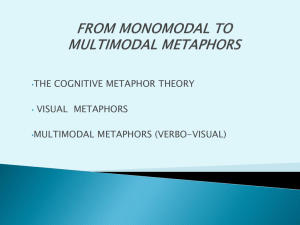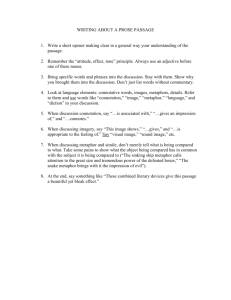Edward de Bono`s techniques for "serious creativity"
advertisement
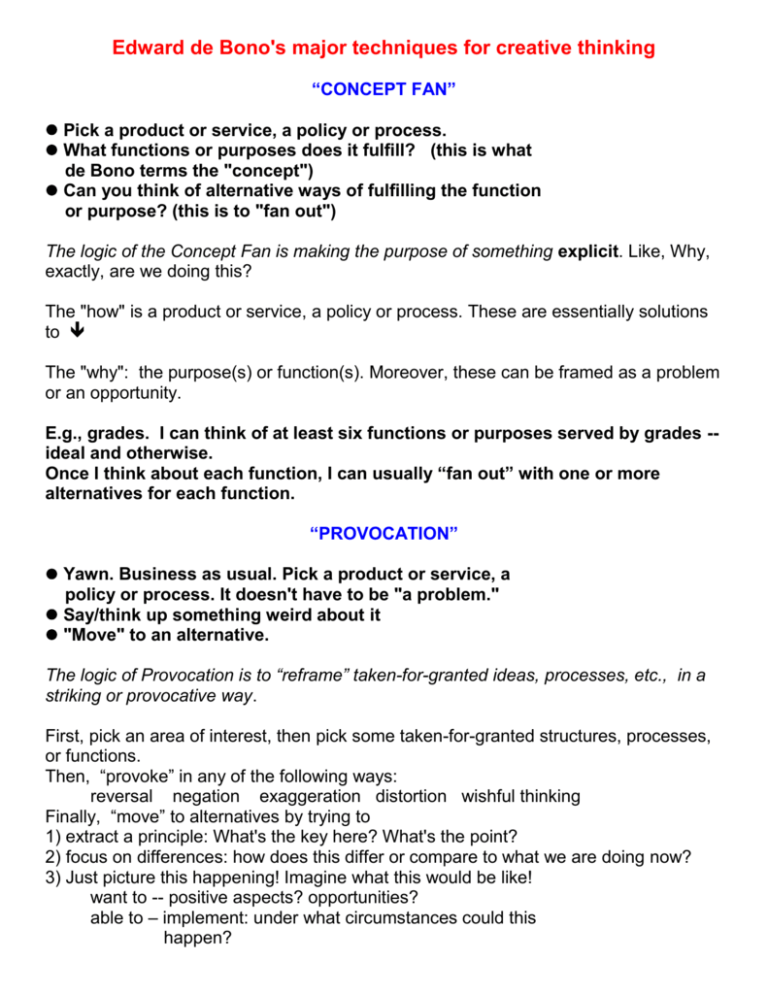
Edward de Bono's major techniques for creative thinking “CONCEPT FAN” Pick a product or service, a policy or process. What functions or purposes does it fulfill? (this is what de Bono terms the "concept") Can you think of alternative ways of fulfilling the function or purpose? (this is to "fan out") The logic of the Concept Fan is making the purpose of something explicit. Like, Why, exactly, are we doing this? The "how" is a product or service, a policy or process. These are essentially solutions to The "why": the purpose(s) or function(s). Moreover, these can be framed as a problem or an opportunity. E.g., grades. I can think of at least six functions or purposes served by grades -ideal and otherwise. Once I think about each function, I can usually “fan out” with one or more alternatives for each function. “PROVOCATION” Yawn. Business as usual. Pick a product or service, a policy or process. It doesn't have to be "a problem." Say/think up something weird about it "Move" to an alternative. The logic of Provocation is to “reframe” taken-for-granted ideas, processes, etc., in a striking or provocative way. First, pick an area of interest, then pick some taken-for-granted structures, processes, or functions. Then, “provoke” in any of the following ways: reversal negation exaggeration distortion wishful thinking Finally, “move” to alternatives by trying to 1) extract a principle: What's the key here? What's the point? 2) focus on differences: how does this differ or compare to what we are doing now? 3) Just picture this happening! Imagine what this would be like! want to -- positive aspects? opportunities? able to – implement: under what circumstances could this happen? E.g., your life. Provoke (wishful thinking): Imagine that you are at your own funeral. Several people are speaking about you. What would you wish them to say? Move: Just picture this happening! E.g., the classroom Provoke (reversal: students teach the teacher. Move: ??? “RANDOM INPUT” You're stuck, you're not coming up with any ways to solve a problem. Talk about the problem, then set it aside for a minute. Randomly pick a noun. List five to seven attributes. Now, compare your map with the problem to see if it sparks anything. The logic of Random Input is juxtaposing two contexts to reveal latent features, relationships, etc. Pick a problematic situation. Randomly pick a noun which people understand. List 5-8 aspects/attributes commonly associated with the noun. Juxtapose the problematic situation and the noun w/ attributes. Play with them to see if anything emerges. E.g., how do you convince your busy boss to attend a two-day creative thinking workshop? Pick a noun -- "chestnut." List some attributes: soft inside, hard shell, Christmas, horses, fireplace, tree. Compare chestnut attributes to problem: hard shell, soft inside? Hmm! ------------------------------------------------------------------------------------------------------------------------------------------------------------------------"For Want of a Metaphor" in The Flamingo's Smile by Stephen Jay Gould (It’s the early to mid-1700s. The microscope has been perfected, allowing scientists to view human eggs and sperm up close for the first time. But at that time, there were no ways to explain -- to understand -- how we developed from such things.) We would say today that Maupertuis's basic insight was correct: complexity cannot arise from formless potential; something must exist in the egg and sperm. But we now hold a radically different concept of this "something." Where Maupertuis could not think beyond actual parts, we have discovered programmed instructions. Eggs and sperm do not carry parts themselves, but only coded instructions, written in DNA, to direct the building of a proper embryo. But how could Maupertuis have reached this elegant solution, for his century lacked analogs in thought and technology to imagine a process of abstraction from actual parts to programmed rules for their construction. Programmed instructions were not part of the intellectual equipment of eighteenthcentury thinkers. Music boxes pointed in the right direction, but the first revolutionary invention based on programmed instructions, the Jacquard loom, was not introduced until the early 1800s. This automatic weaving device, with instructions on punched cards, directly inspired Hollerith's later invention of data cards for census machines (later transmogrified to the famous IBM computer card-do not fold, spindle, or mutilate). How could Maupertuis imagine the correct solution to his dilemma-programmed instructions--in a century that had no player pianos, not to mention computer programs? We often think, naïvely, that missing data are the primary impediments to intellectual progress-just find the right facts and all problems will dissipate. But barriers are often deeper and more abstract in thought. We must have access to the right metaphor, not only to the requisite information. Revolutionary thinkers are not, primarily, gatherers of facts, but weavers of new intellectual structures. Ultimately, Maupertuis failed because his age had not yet developed a dominant metaphor of our own time--coded instructions as the precursor to material complexity. The Computer Model of the Mind There is another reason for the "that's not logical" mental lock. As an historian of ideas, I've noticed that the models people use to understand mental processes reflect the technology of their time. For example, in the 17th century, people thought about the mind as though it were a mirror or lens, and this "mirrors" the advances made then in the fields of optics and lens-making. The Freudian model of mind, developed in the late 19th and early 20th centuries, seems based on the ubiquity of the stem engine locomotive. Ideas and thoughts billow up from the subconscious to the conscious in the same way steam moves from boiler to compression chamber. In the early twentieth century, the mind was viewed by some as a vast telephone switching network with circuits and relays running through the brain. For the past twenty years, we've had a new model of mind: the computer. This model does a good job of describing certain aspects of our thinking. For example, we have "input" and "output" and "information-processing." There is also "feedback," "programming," and "storage." This is fine as far as it goes, but some people take this model literally and think that the mind really is a computer. As a result, they may dismiss the soft types of thinking as not being "logical." Indeed, I've even seen adherents of this model treat other people like machines. How many times have you heard someone say, "I interface with that person," or "I'm operating in panic mode," or "I need to make an information dump on you"? The best one I heard was by a man describing the different parts of a computer system: "There is hardware, software, firmware, and liveware." Liveware is the people-element of the system. I believe that the mind is not only a computer that processes information, it's also a museum that stores experiences, a device that encodes holograms, a playground in which to play, a muscle to be strengthened, a compost pile to be turned, a workshop in which to construct thoughts, a debating opponent to be won over, a cat to be stroked, a funhouse to be explored, and forty-three others. There are a lot of right ways to model the mind--all depending on what you think is important. -------------------------------------------------------------------------------------------------------------------------------------- From The Social Psychology of Organizing, Karl Weick There is one metaphor that dominates the business world. That metaphor is the military. It suggests the way people in business think about themselves and what they do. Consider these samples of organizational talk. Organizations have a staff, line, and chain of command. They develop strategy and tactics. Organizations give people marching orders, pass muster, attack competitors, recruit MBAs, conduct basic training, converse with the brass at headquarters, wage campaigns, access the rank and rile, field well-drilled salesmen, deplore a garrison mentality, retreat, gather intelligence, do battle, fire traitors, recruit spies, consider mutiny, employ diversionary tactics, launch frontal assaults, discipline their troops, and lament that the code of conduct doesn’t work. Why does the military metaphor have such a grip on managers? For one thing, a military metaphor is an ideal self-fulfilling prophecy. Suppose I go into a situation assuming that the person I’m about to meet wants to fight. That person sees my hostile, menacing appearance and responds in kind with a hostile display. So I conclude that my original prediction was correct: the other person did want to fight. It never dawns on me that I’m the one who creat4ed the fight. It’s the same with business. If I assume that doing business is like waging war, then this presumption creates the very wars that I predicted. Since I never realize the true origins of those wars in my own presumptions, the wars and the combat go on and on. But military metaphors might persist for other reasons. People don’t like to deal with uncertainty and disorder, so they impose military trappings like hierarchies and they impose spans of control to conceal the disorder. Military imagery probably also persists because it is tough, macho, exciting. One might even suppose that military metaphors persist because business attracts authoritarian people to powerful positions where those people then impose their view of the world on others. Remember, authoritarian people are not just autocrats. They adhere to conventional values and condemn those who don’t; they are opposed to anything that is subjective and tender-minded; they are preoccupied with dominance-submission, strong-weak, and leader-follower in any relationship; they have an uncritical attitude toward their own group, and they are concerned with knowing the right people rather than with any exchange of affection. Those characteristics sound just like what you would expect to find in a military organization. If that same pattern is also found among the top people in nonmilitary organizations, then it is not too surprising that as their vision diffuses down through the organization, people will describe the place with military language. Whatever its origins, the military metaphor is a bad choice when used alone because it forces people to entertain a very limited set of solutions to solve any problem and a very limited set of ways to organize themselves. They solve problems by discharging people (honorably or otherwise), tightening controls, introducing discipline, sending for reinforcements, or clarifying responsibilities – since that’s what you do when an army sags. And the only way they know to organize themselves is into some kind of hierarchy. Chronic usage of the military metaphor will lead people repeatedly to overlook a different kind of organization, one that values improvisation rather than forecasting, dwells on opportunities rather than constraints, invents solutions rather than borrows them, devises new actions rather than defends past actions, values argument more highly than serenity, and encourages doubt and contradiction rather than belief. That kind of organization has advantages that a military organization doesn’t, but to see those advantages, different metaphors are needed. …Other metaphors are needed to capture different realities that exist right alongside those military realities. Metaphors We Live By, by Lakoff and Johnson 1 Concepts We Live By Metaphor is for most people a device of the poetic imagination and the rhetorical flourish – a matter of extraordinary rather than ordinary language. Moreover, metaphor is typically viewed as characteristic of language alone, a matter of words rather than thought or action. For this reason, most people think they can get along perfectly well without metaphor. We have found, on the contrary, that metaphor is pervasive in everyday life, not just in language but in thought and action. Our ordinary conceptual system, in terms of which we both think and act, is fundamentally metaphorical in nature. The concepts that govern our thought are not just matters of the intellect. They also govern our everyday functioning, down to the most mundane details. Our concepts structure what we perceive, how we get around in the world, and how we relate to other people. Our conceptual system thus plays a central role in defining our everyday realities. If we are right in suggesting that our conceptual system is largely metaphorical, then the way we think, what we experience, and what we do every day is very much a matter of metaphor. But our conceptual system is not something we are normally aware of. In most of the little things we do every day, we simply think and act more or less automatically along certain lines. Just what these lines are is by no means obvious. One way to find out is by looking at language. Since communication is based on the same conceptual system that we use in thinking and acting, language is an important source of evidence for what that system is like. Primarily on the basis of linguistic evidence, we have found that most of our ordinary conceptual system is metaphorical in nature. And we have found a way to begin to identify in detail just what the metaphors are that structure how we perceive, how we think and what we do. To give some idea of what it could mean for a concept to be metaphorical and for such a concept to structure an everyday activity, let us start with the concept ARGUMENT and the conceptual metaphor ARGUMENT IS WAR. This metaphor is reflected in our everyday language by a wide variety of expressions. ARGUMENT IS WAR ` Your claims are indefensible. He attacked every weak point in my argument. His criticisms were right on target. I demolished his argument. I’ve never won an argument with him. You disagree? Okay, shoot! If you use that strategy, he’ll wipe you out. He shot down all of my arguments. It is important to see that we don’t just talk about arguments in terms of war. We can actually win or lose arguments. We see the person we are arguing with as an opponent. We attack his positions and we defend our own. We gain and lose ground. We plan and use strategies. If we find a position indefensible, we can abandon it and take a new line of attack. Many of the things we do in arguing are partially structured by the concept of war. Though there is no physical battle, there is a verbal battle, and the structure of an argument – attack, defense, counterattack, etc. – reflects this. It is in this sense that the ARGUMENT IS WAR metaphor is one that we live by in this culture; it structures the actions we perform in arguing. Try to image a culture where arguments are not viewed in terms of war, where no one wins or loses, where there is no sense of attacking or defending, gaining or losing ground. Imagine a culture where an argument is viewed as a dance, the participants are seen as performers, and the goal is to perform in a balanced and aesthetically pleasing way. In such a culture, people would view arguments differently, experience them differently, carry them out differently, and talk about them differently. But we could probably not view them as arguing at all: they would simply be doing something different. It would seem strange even to call what they were doing “arguing.” Perhaps the most neutral way of describing this difference between their culture and ours would be to say that we have a discourse form structured in terms of battle and they have on structured in terms of dance. This is an example of what it means for a metaphorical concept, namely, ARGUMENT IS WAR, to structure (at least in part) what we do and how we understand what we are going when we argue. The essence of metaphor is understanding and experiencing one kind of thing in terms of another. It is not that arguments are a subspecies of war. Arguments and wars are different kinds of things – verbal discourse and armed conflict – and the actions performed are different kinds of actions. But ARGUMENT is partially structured, understood, performed, and talked about in terms of WAR. The concept is metaphorically structured, and, consequently, the language is metaphorically structured. Moreover, this is the ordinary way of having an argument and talking about one. The normal; way for us to talk about attacking a position is to use the words “attack a position.” Our conventional ways of talking about arguments presuppose a metaphor we are hardly ever conscious of. The metaphor is not merely in the words we use – it is in our very concept of any argument. The language of arguments is not poetic, fanciful, or rhetorical; it is literal. We talk about arguments that way because we conceive of them that way – and we act according to the way we conceive of things. The most important claim we have made so far is that metaphor is not just a matter of language, that is, of mere words. We shall argue that, on the contrary, human thought processes are largely metaphorical. This is what we mean when we say that the human conceptual system is metaphorically structured and defined. Metaphors as linguistic expressions are possible precisely because there are metaphors in a person’s conceptual system. Therefore, wherever in this book we speak of metaphors, such as ARGUMENT IS WAR, it should be understood that metaphor means metaphorical concept. 2 The Systematicity of Metaphorical Concepts Arguments usually follow patterns; that is, there are certain things we typically do and do not do in arguing. The fact that we in part conceptualize arguments in terms of battle systematically influences the shape arguments take and the way we talk about what we do in arguing. Because the metaphorical concept is systematic, the language we use to talk about that aspect of the concept is systematic. We saw in the ARGUMENT IS WAR metaphor that expressions from the vocabulary of war, e.g., attack a position, indefensible, strategy, new line of attack, win, grain ground, etc., form a systematic way of talking about the battling aspects of arguing. It is no accident that these expressions mean what they mean when we use them to talk about arguments. A portion of the conceptual network of battle partially characterizes the concept of an argument, and the language follows suit. Since metaphorical expressions in our language are tied to metaphorical concepts in a systematic way, we can use metaphorical linguistic expressions to study the nature of metaphorical concepts and to gain an understanding of the metaphorical nature of our activities. To get an idea of how metaphorical expressions in everyday language can give us insight into the metaphorical nature of the concepts that structure our everyday activities, let us consider the metaphorical concept TIME IS MONEY as it is reflected in contemporary English. TIME IS MONEY You’re wasting my time. This gadget will save you hours. I don't have the time to give you. How do you spend your time these days? That flat tire cost me an hour. I’ve invested a lot of time in her. I don’t have enough time to spare for that. You’re running out of time. You need to budget your time. Put aside some time for ping pong. Is that worth your while? Do you have much time left? He’s living on borrowed time. You don’t use your time profitably. I lost a lot of time when I got sick. Thank you for your time. Time in our culture is a valuable commodity. It is a limited resource that we use to accomplish our goals. Because of the way that the concept of work ahs developed in modern Western culture, where work is typically associated with the time it takes and time is precisely quantified, it ahs become customary to pay people by the hour, week, or year. In our culture TIME IS MONEY in many ways: telephone message units, hourly wages, hotel room rates, yearly budgets, interest on loans, and paying your debt to society by “serving time.” These practices are relatively new in the history of the human race, and by no means do they exist in all cultures. They have arisen in modern industrialized societies and structure our basic everyday activities in a very profound way. Corresponding to the fact that we act as if time is a valuable commodity – a limited resource, even money – we conceive of time that way. Thus we understand and experience time as the kind of thing that can be spent, wasted, budgeted, invested wisely or poorly, saved, or squandered. TIME IS MONEY, TIME IS A LIMTED RESOURCE, and TIME IS A VALUABLE COMMODITY are all metaphorical concepts. They are metaphorical since we are using our everyday experiences with money, limited resources, and valuable commodities to conceptualize time. This isn’t a necessary way for human beings to conceptualize time; it is tied to our culture. There are cultures where time is none of these things. The metaphorical concepts TIME IS MONEY, TIME IS A RESOURCE, and TIME IS A VALUABLE COMMODITY form a single system based on sub categorization, since in our society money is a limited resource and limited resources are valuable commodities. These sub categorization relationships characterize entailment relationships between the metaphors. TIME IS MONEY entails that TIME IS A LIMITED RESOURCE, which entails that TIME IS A VALUABLE COMMODITY. We are adopting the practice of using the most specific metaphorical concept, in this case TIME IS MONEY, to characterize the entire system. Of the expressions listed under the TIME IS MONEY metaphor, some refer specifically to money (spend, invest, budget, profitably, cost), others to limited resources (use, use up, have enough of, run out of), and still other to valuable commodities (have, give, lose, than you for). This is an example of the way in which metaphorical entailments can characterize a coherent system of metaphorical concepts and a corresponding coherent system of metaphorical expressions for those concepts. 3 Metaphorical Systematicity: Highlight and Hiding The very systematicity that allows us to comprehend one aspect of a concept in terms of another (e.g., comprehending an aspect of arguing in terms of battle) will necessarily hide other aspects of the concept. In allowing us to focus on one aspect of a concept (e.g., the battling aspects of arguing), a metaphorical concept can keep us from focusing on other aspects of the concept that are inconsistent with that metaphor. For example, in the midst of a heated argument, when we are intent on attacking our opponent’s position and defending our own, we may lose sight of the cooperative aspects of arguing. Someone who is arguing with you can be viewed as giving you his time, a valuable commodity, in an effort at mutual understanding. But when we are preoccupied with the battle aspects, we often lose sight of the cooperative aspects. A far more subtle case of how a metaphorical concept can hide an aspect of our experience can be seen in what Michael Reddy has called the “conduit metaphor.” Reddy observes that our language about language is structured roughly by the following complex metaphor: IDEAS (OR MEANINGS) ARE OBJECTS. LINGUISTIC EXPRESIONS ARE CONTAINERS. COMMUNCATION IS SENDING. The speaker puts ideas (objects) into words (containers) and sends them (along a conduit) to a hearer who takes the idea/objects out of the word/containers. Reddy documents this with more than a hundred types of expressions in English, which he estimates account for at least 70 percent of the expressions we use for talking about language. Here are some examples: The CONDUIT Metaphor It’s hard to get that idea across to him. I gave you that idea. Your reasons came through to us. It’s difficult to put my ideas into words. When you have a good idea, try to capture it immediately in words. Try to pack more thoughts into fewer words. You can’t simply stuff ideas into a sentence any old way. The meaning is right there in the words. Don't’ force your meanings into the wrong words. His words carry little meaning. The introduction has a great deal of thought content. Your words seem hollow. The sentence is without meaning. The idea is buried in terribly dense paragraphs. In examples like these it is far more difficult to see that there is anything hidden by the metaphor or even to see that there is a metaphor here at all. This is so much the conventional way of thinking about language that it is sometimes hard to imagine that it might not fit reality. But if we look at what the CONDUIT metaphor entails, we can se some of the ways in which it masks aspects of the communicative process. First, the LINGUISTIC EXPRESSIONS ARE CONTAINERS FOR MEANINGS aspect of the CONDUIT metaphor entails that words and sentences have meanings in themselves, independent of any context or speaker. The MEANINGS ARE OBJECTS part of the metaphor, for example, entails that meanings have an existence independent of people and contexts. The part of the metaphor that says LINGUISTIC EXPRESSSIONS ARE CONTAINERS FOR MEANING entails that words (and sentences have meanings, again independent of contexts and speakers. These metaphors are appropriate in many situations – those where context differences don’t matter and where all the participants in the conversation understand the sentences in the same way. These two entailments are exemplified by sentences like The meaning is right there in the words, which, according to the CONDUIT metaphor, can correctly be said of any sentence. But there are many cases where context does matter. Here is a celebrated one recorded in actual conversation by Pamela Downing: Please sit in the apple-juice seat. In isolation this sentence has no meaning at all, since the expression “apple-juice seat” is not a conventional way of referring to any kind of object. But the sentence makes perfect sense in the context in which it was uttered. An overnight guest came down to breakfast. There were four place settings, three with orange juice and one with apple juice. It was clear what the apple-juice seat was. And even the next morning, when there was no apple juice, it was still clear which seat was the apple-juice seat. In addition to sentences that have no meaning without context, there are cases where a single sentence will mean different things to different people. Consider: We need new alternative sources of energy. This means something very different to the president of Mobil Oil from what it means to the president of Friends of the Earth. The meaning is not right there in the sentence – it matters a lot who is saying or listening to the sentence and what his social and political attitudes are. The CONDUIT metaphor does not fit bases where context is required to determine whether the sentence has any meaning at all and, if so, what meaning it has. These examples show that the metaphorical concepts we have looked at provide us with a partial understanding of what communication, argument, and time are and that, in doing this, they hide other aspects of these concepts. It is important to see that the metaphorical structuring involved here is partial, not total. If it were total, one concept would actually be the other, not merely be understood in terms of it. For example, time isn’t really money. If you spend your time trying to do something and it doesn’t work, you can’t get your time back. There are no time banks. I can give you a lot of time, but you can’t give me back the same time, though you can give me back the same amount of time. And so on. Thus, part of a metaphorical concept does not and cannot fit. On the other hand, metaphorical concepts can be extended beyond the range of ordinary literal ways of thinking and talking into the range of what is called figurative, poetic, colorful, or fanciful thought and language. Thus, if ideas are objects, we can dress them up in fancy clothes, juggle them, line them up nice and neat, etc. So when we say that a concept is structured by a metaphor we mean that it is partially structured and that it can be extended in some ways but not others. 4 Orientational Metaphors So far we have examined what we will call structural metaphors, cases where one concept is metaphorically structured in terms of another. But there is another kind of metaphorical concept, one that does not structure one concept in terms of another but instead organizes a whole system of concepts with respect to one another. We will call these orientational metaphors, since most of them have to do with spatial orientation: up-down, in-out, front-back, on-off, deep-shallow, centralperipheral. These spatial orientations arise from the fact that we have bodies of the sort we have and that they function as they do in our physical environment. Orientation metaphors give a concept a spatial orientation: for example, HAPPY IS UP. The fact that the concept HAPPY is oriented UP leads to English expressions like “I’m feeling up today. --------------------------------------------------------------------------------------------------------------------------------------

